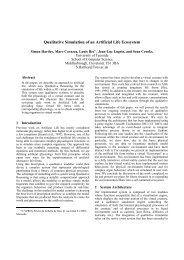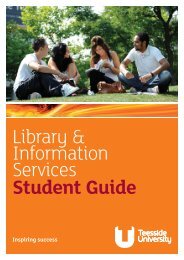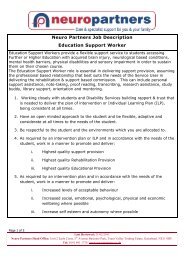Research and Enterprise, Issue 9 - University of Teesside
Research and Enterprise, Issue 9 - University of Teesside
Research and Enterprise, Issue 9 - University of Teesside
You also want an ePaper? Increase the reach of your titles
YUMPU automatically turns print PDFs into web optimized ePapers that Google loves.
<strong>Research</strong> <strong>and</strong> <strong>Enterprise</strong><br />
24<br />
>DIGITAL TEESSIDE<br />
How was your day?<br />
If your partner is fed up with you moaning about work, help may be at h<strong>and</strong> through an<br />
amazing piece <strong>of</strong> interactive s<strong>of</strong>tware that does more than just provide a sympathetic hearing.<br />
DAVID WILLIAMS finds out more from Marc Cavazza.<br />
✒<br />
It's a companion, an adviser <strong>and</strong> a life coach,<br />
but it's also virtual <strong>and</strong> powered by artificial<br />
intelligence.<br />
It's called an Embodied Conversational Agent<br />
(ECA): a system which makes human-computer<br />
dialogue more realistic <strong>and</strong> acceptable by<br />
mediating it through on-screen characters<br />
animated in real-time.<br />
But, while previous research mostly developed<br />
them as personal assistants, a new generation <strong>of</strong><br />
ECAs is much closer to being able to engage in<br />
natural conversations with their owners <strong>and</strong> so<br />
establish personal relationships because they<br />
can respond to human emotions.<br />
‘The breakthrough has come from recent<br />
progress in affective dialogue systems’, explains<br />
Pr<strong>of</strong>essor Marc Cavazza, Director <strong>of</strong> the Digital<br />
Futures Institute at <strong>Teesside</strong> <strong>University</strong>, whose<br />
team developed the system. ‘It means that a<br />
companion agent can now depart from simple<br />
task-based dialogue.’<br />
Pr<strong>of</strong>essor Cavazza's team recently<br />
demonstrated the new virtual companion at the<br />
biennial ICT conference in Brussels, where<br />
conference-goers were presented with an ECA<br />
engaging in an open conversation, albeit on a<br />
limited number <strong>of</strong> topics.<br />
‘To demonstrate its potential, we choose an<br />
everyday situation that would support conversation<br />
with some affective content’, says Dr Cameron<br />
Smith, who helped develop the system.<br />
‘We opted for a scenario in which the user, a<br />
typical <strong>of</strong>fice worker, returns home <strong>and</strong> complains<br />
about her day in the <strong>of</strong>fice. We refer to this as the<br />
'How was your day?' scenario.<br />
‘The companion does more than provide a<br />
sympathetic hearing as one might expect from<br />
such an application’, adds Pr<strong>of</strong>essor Cavazza.<br />
‘It also demonstrates a true underst<strong>and</strong>ing, not<br />
only <strong>of</strong> the events described by the user, but also<br />
<strong>of</strong> her own attitude towards the situation.<br />
‘The system works by appraising its owner’s<br />
reaction to the event reported, so as to determine<br />
whether it should comfort the user or provide<br />
some advice instead.’<br />
The prototype currently supports some 50<br />
work-based topics <strong>of</strong> conversation, such as<br />
meetings, company restructuring <strong>and</strong><br />
relationships with colleagues.<br />
The system analyses what the user is saying<br />
for its emotional content, both at speech <strong>and</strong> text<br />
level, <strong>and</strong> then assigns an emotional category to<br />
each event description. This is used to determine<br />
the appropriateness <strong>of</strong> the user’s emotional<br />
reaction to the events. The companion then uses<br />
an affective strategy to influence the user.<br />
Depending on its analysis, it may choose<br />
to comfort the user or provide some<br />
warning about the possible evolution <strong>of</strong><br />
the situation. The sequence <strong>of</strong> utterances<br />
is designed to convey gradually the<br />
message to the user, for instance by<br />
initially expressing agreement <strong>and</strong><br />
empathy. Each is also associated with<br />
emotional content which is expressed<br />
by real-time animation <strong>of</strong> the<br />
companion's facial expressions<br />
<strong>and</strong> gestures.<br />
‘Hello, how<br />
did your day go?’<br />
‘What do you think<br />
will happen next?’<br />
More information about the project can be found at www.companions-project.org.<br />
The work was funded by the European Commission as part<br />
<strong>of</strong> the Information Society Technologies (IST) programme.

















